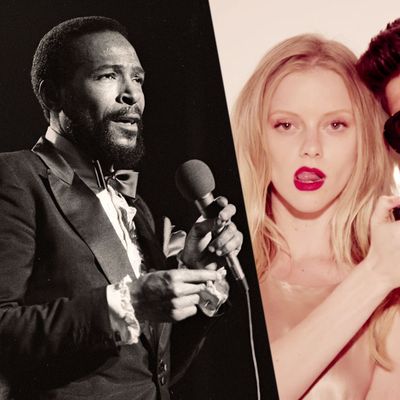
Robin Thicke and Pharrell have been dealt yet another blow in their years-long battle to prove they did not copy Marvin Gaye. In 2015, the pair lost a lawsuit filed by Gaye’s family that claimed Thicke’s “Blurred Lines” stole from “Got to Give It Up.” It was a landmark, controversial case that seems to have altered the course of music copyright — a rise in litigation at the faintest suspicion of theft between two artists has been credited to the “Blurred Lines effect.” Now, Thicke and Pharrell have lost their appeal.
A three-judge panel at the Ninth Circuit Court of Appeals this week upheld the original verdict, ruling that Thicke and Pharrell will, indeed, have to pay millions to the Gaye family. (The only change is that T.I., featured on the song, no longer has to pay.) How did the judges arrive at this decision and how might it affect the music industry at large? Jeff Peretz, copyright expert and professor at NYU’s Clive Davis Institute of Recorded Music, explains.
What, exactly, were Thicke and Pharrell appealing?
It’s important to recognize that the job of the appeals court is not to retry the merits of the case, but rather to look at whether or not there were any errors in procedure in the original case. Pharrell and Thicke were arguing that there were. And while a case can be made that the deliberations over whether or not to let the jury hear a recording was indeed such an error, two-thirds of the panel did not deem it so.
What’s the “thin protection” argument, and why didn’t it work for Thicke and Pharrell?
In their defense, Thicke and Pharrell claimed that Gaye’s copyright only gave his music “thin” protection. In this case, the “thin” copyright argues that “Got to Give It Up” relies heavily on commonly used tropes of its genre and is not all that original in its own right. So for it to be infringed upon, the infringer would have to copy it almost verbatim. But that argument confuses the “how” with the “what” of a composition. “What” the song is speaks to its collection of rhythms, melodies, harmonies, and lyrics, as well as its structure, none of which are even remotely close between these two compositions. So if this case were limited only to the sheet music (the “what”), there would be no case. Further, only melody and lyrics are traditionally deemed copyrightable.
But the issue at stake in this case is the “how,” not the “what” — in other words, how the song is presented. Pharrell admittedly set out to create a “party” song in the style of “GTGIU” knowing full well it was within the legal boundaries to do so. He, in essence, walked right up to the legal line but made sure not to cross it. What the original decision did was move the line. By letting it stand in appeal, Judge Milan D. Smith Jr., who wrote the majority opinion, has literally changed the rules. But if the difference between “what” and “how” were properly explained to the jury the first time around, this never would have gotten this far.
Why does T.I. get off the hook?
This speaks to the idea of T.I.’s involvement as a “vicarious writer” of the song. (In other words, he came into the creation of the song late in the game and his contributions were minimal.) The appeals court agrees that originally lumping him in was wrong and, therefore, he has no responsibility to make reparations.
Ultimately, why did Thicke and Pharrell lose?
It seems to me the decision is saying that lawyers for Thicke and Pharrell did not supply ample procedural reasoning to rethink the verdict and provide a compelling enough case that the original trial was flawed. Simply put, you can’t retry a case just because you didn’t like the verdict.
Was the decision unanimous?
No. The decision was 2-1, with Judge Jacqueline Nguyen writing a sharp dissent that strongly disagreed with the original verdict.
Does this decision mean the original verdict was correct?
Keep in mind that none of the points made in the appeals decision have to do with the ethics of the verdict. Long story short, the original jury got it wrong, in my opinion, after being properly instructed on their duty. What happened now is that a panel of judges decided 2-1 that the original case was indeed properly handled, not necessarily that the verdict was just or correct.
But is it the right decision?
The precedent that it sets is bad news for creativity, as Judge Nguyen wrote — it allows the Gayes to “copyright a style.” Judge Smith does not appear to recognize the door he’s opened for older artists to sue current artists for acknowledging the former’s influence on their work. The original verdict is a dangerous and slippery slope that allows acrimony and general bad faith to come between artists who should and would otherwise appreciate each other. It’s also completely responsible for the litigious environment surrounding popular music in the time since the “Blurred Lines” verdict came down. I can think of a number of songs in the current top 20 that could be equally as guilty of this new type of infringement if this indeed is the new standard.
The ultimate effect will be to limit creativity and stifle innovation, which goes against the very reason these ideas were included in the Constitution in the first place: to promote the arts, not to determine and/or to protect ownership.
Is the case now closed?
I would imagine that the next step will be to let the Supreme Court look into all of it, as it does seem that “Blurred Lines” will go down as one of the most important cases in the history of music copyright.

